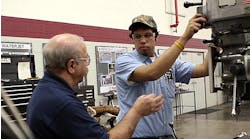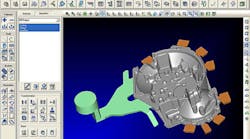A question hung in the air, as though everyone had already wondered the same thing in private, and secretly wanted to answer, and even more secretly wanted someone else to answer, but no one dared to voice their opinion: Why don’t more metalcasters claim ownership rights over the designs they produce?
The setting was reasonably safe, meaning “confidential.” We’d gathered a few dozen metalcasting executives to a forum to discuss some research findings. By all accounts and subsequent evaluations the event was a success and very well appreciated, and that’s to the credit of all the participants who joined the discussion with so much candor. Still, that question of ownership remains unanswered and un-discussed, and I suspect it will remain that way until the facts change. But, they are changing now.
Of course, some metalcasters do make proprietary claims about their products, but usually these are based on metallurgy or process technology — heat times and temperatures for example, or subsequent treatments like coating or atmospheric processing. Almost always, however, the design of a casting is the property of the buyer. This is why foundries and diecasters go to such lengths to emphasize other factors that distinguish their enterprises: product quality, speed of delivery, customer service, product finishing, fabricating and assembly, or other value-adding processes and services, are all options that metalcasters take up to distinguish their enterprises. They have to do this, because in the final breakdown the one who owns the design controls the transaction, and that puts metalcasters at constant risk of “commoditization.”
By controlling the design the buyer is able compare the work of one metalcaster to another (thus their need to distinguish other factors), and extract some concessions on cost (and/or other details) in return for placing that order.
Production volume is a factor too – because higher volumes typically reduce production costs. So, metalcasters are hopeful of increasing production volumes, and may concede some of their profits to the buyer in order earn the assignment. The one who controls the casting design dictates the volumes to be produced, and in that way dictates production costs to the metalcaster.
Generally, there is nothing ‘wrong’ about the current arrangement, though it establishes all manner of opportunities for cheating by either or both sides of the transaction (as almost everyone knows, by anecdote or experience.) It is an arrangement that continues by mutual consent of metalcasters and casting buyers.
It’s the mutual consent that I believe is changing, and that only because so many other aspects of manufacturing are in flux, too. The technology needed for product design and development is more widely available than at any time in the past. Information can be gathered at little or no cost – or duplicated, or imitated, even if the original sources are unavailable, or lost or unknown.
Equally important, the job of finding and securing a buyer for a product is simpler now than ever before. The commercial and industrial landscape that developed over the past 300 years assigned distinct roles to designers, producers, distributors, and consumers, but it no longer pertains to the world in which we work and live. The turnover may result in metalcasters ‘owning’ the designs they produce, thus gaining more control over the value of those products — but it will come with more risks and responsibilities, and none of the assurances about how buyers, other producers, or material and service suppliers will behave.
What we’re facing in metalcasting, and manufacturing, is a narrower version of the political and economic debates about ‘inequality,’ with all the same alarming implications about individuals’ rights, privileges, and responsibilities. There is much to be gained by having this debate, and much to be lost by losing it.










